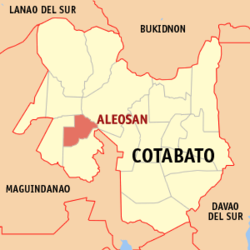Aleosan
This article needs additional citations for verification. (June 2014) |
Aleosan | |
|---|---|
| Municipality of Aleosan | |
 Map of Cotabato with Aleosan highlighted | |
Location within the Philippines | |
| Coordinates: 7°09′31″N 124°34′32″E / 7.15855°N 124.575436°E | |
| Country | |
| Region | Soccsksargen |
| Province | Cotabato |
| District | 1st District |
| Founded | April 6, 1982 |
| Barangays | 19 (see Barangays) |
| Government | |
| • Type | Sangguniang Bayan |
| • Mayor | Vicente C. Sorupia Jr. |
| • Vice Mayor | Eduardo C. Cabaya |
| • Electorate | 22,457 voters (2022) |
| Area | |
| • Total | 225.44 km2 (87.04 sq mi) |
| Population (2020 census)[3] | |
| • Total | 36,892 |
| • Density | 160/km2 (420/sq mi) |
| Time zone | UTC+8 (PST) |
| ZIP code | 9415 |
| PSGC | |
| IDD : area code | +63 (0)64 |
| Income class | 3rd municipal income class |
| Revenue (₱) | ₱ 161 million (2020) |
| Native languages | Hiligaynon Cebuano Maguindanao Ilianen Tagalog |
| Website | www |
Aleosan, officially the Municipality of Aleosan, is a 3rd class municipality in the province of Cotabato, Philippines. According to the 2020 census, it has a population of 36,892 people.[3]
Geography
Aleosan is within the political boundary of Cotabato Province. It is approximately 65 kilometres (40 mi) from the capital town of Amas which is barely two (2) hours ride from the seat of its municipal government. It is bounded on the west by Midsayap; on the north by Libungan and on the east and south by Pikit. It is accessible to land transportation from Cotabato City traversing the municipalities of Maguindanao to Kidapawan up to Davao City, as it is located along the major transport route linking the provinces of Maguindanao, Cotabato and Davao del Sur.
Barangays
Aleosan is politically subdivided into 19 barangays. [2] The seat of the municipal government is in barangay San Mateo.
- Bagolibas
- Cawilihan
- Dualing
- Dunguan
- Katalicanan
- Lawili
- Lower Mingading
- Luanan
- Malapang
- New Leon
- New Panay
- Pagangan
- Palacat
- Pentil
- San Mateo
- Santa Cruz
- Tapodoc
- Tomado
- Upper Mingading
Climate
Aleosan area belongs to the fourth type of climate or the intermediate "E" with no distinct dry season. Rainfall is evenly distributed throughout the year with heavier rains from May to September. This type of climate conditions is suitable for the production of crops like rice, corn, mangoes, jackfruit, vegetables and root crops, which are considered seasonal crops and permanent crops like coconut, rubber, coffee, cacao and orchard crops.
History
The name Aleosan is an acronym derived from the three (3) towns of Iloilo where majority of the early Christian settlers came from; A is for Alimodian, LEO is for Leon, and SAN for San Miguel.[4]
Parliamentary bill no. 670 authored by Assemblyman Jesus P. Amparo and co-authored by assemblymen Blah T. Sinsuat, Ernesto F. Roldan and Tomas B. Baga Jr. sought to establish and create the Municipality of Aleosan in the Province of Cotabato, which was ultimately approved and signed into law Batas Pambansa bilang 206 on April 6, 1982. For purposes of ratification, Proclamation No. 2188 was signed by President Ferdinand E. Marcos on April 29, 1982. A plebiscite was conducted on May 7, 1982 which was unanimously confirmed the desire and aspiration of the people in the nineteen (19) barangays to become a distinct and regular municipality from Pikit its mother municipality.
Demographics
| Year | Pop. | ±% p.a. |
|---|---|---|
| 1990 | 22,574 | — |
| 1995 | 25,408 | +2.24% |
| 2000 | 26,164 | +0.63% |
| 2007 | 32,874 | +3.20% |
| 2010 | 35,746 | +3.09% |
| 2015 | 39,405 | +1.87% |
| Source: Philippine Statistics Authority[5][6][7][8] | ||
In the 2020 census, the population of Aleosan, Cotabato, was 36,892 people,[3] with a density of 160 inhabitants per square kilometre or 410 inhabitants per square mile.
Economy
The municipality is endowed with abundant agricultural raw materials suitable for processing. These include coconut, banana, rubber, mango and coffee. There are small-scale enterprises but these are not sustainable due to inadequate capital. A cassava processing plant was shut down due to insufficient supply of raw materials and low quality of starch produced. The area however, is best suited for mango production and there is a need to develop the industry to cater the growing needs of the locality. The municipality's livestock industry has great potentials being one of the top producers and supplier of livestock in the province.
Tourist attractions
- Brgy Malapang – Mountain climbing
- Brgy Pentil – Eco tourism
- Brgy Katalicanan - UK Peak
References
- ^ Municipality of Aleosan | (DILG)
- ^ a b "Province: North Cotabato". PSGC Interactive. Quezon City, Philippines: Philippine Statistics Authority. Retrieved 12 November 2016.
- ^ a b c Census of Population (2020). "Region XII (Soccsksargen)". Total Population by Province, City, Municipality and Barangay. Philippine Statistics Authority. Retrieved 8 July 2021.
- ^ http://www.cotabatoprov.gov.ph/lgus/aleosan
- ^ Census of Population (2015). "Region XII (Soccsksargen)". Total Population by Province, City, Municipality and Barangay. Philippine Statistics Authority. Retrieved 20 June 2016.
- ^ Census of Population and Housing (2010). "Region XII (Soccsksargen)" (PDF). Total Population by Province, City, Municipality and Barangay. National Statistics Office. Retrieved 29 June 2016.
- ^ Censuses of Population (1903–2007). "Region XII (Soccsksargen)". Table 1. Population Enumerated in Various Censuses by Province/Highly Urbanized City: 1903 to 2007. National Statistics Office.
{{cite encyclopedia}}: CS1 maint: numeric names: authors list (link) - ^ "Province of North Cotabato". Municipality Population Data. Local Water Utilities Administration Research Division. Retrieved 17 December 2016.

